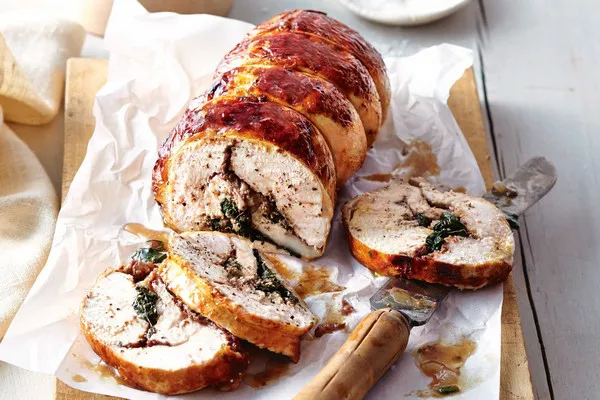The art of French cuisine is often characterized by its elegance, creativity, and meticulous techniques. Among the many culinary masterpieces, the ballotine stands out as a testament to the skill and innovation of chefs around the world. A ballotine is a culinary marvel that combines deboning, stuffing, and intricate presentation to create a dish that delights the senses and showcases culinary finesse. In this comprehensive guide, we will delve into the step-by-step process of crafting a ballotine, allowing you to unlock the secrets of this exceptional dish and create your own culinary masterpiece.
How To Make a Ballotine

A ballotine is a culinary term that refers to a method of preparing and presenting boneless meat, poultry, or fish, usually stuffed and rolled into a cylindrical shape. It's a technique that creates an elegant and impressive dish. Here's a general outline of how to make a ballotine:
- A roasting pan or oven-safe dish
- Boneless meat, poultry, or fish of your choice
- Stuffing ingredients (e.g., herbs, vegetables, cheese, etc.)
- Salt and pepper
- Kitchen twine
- Cooking oil or butter
- Broth or other cooking liquid (optional)
-
Start with a boneless piece of protein. You might need to ask your butcher to debone the meat or fillet the fish for you.
-
Lay the meat or fish flat on a clean surface. Use a sharp knife to trim and shape it if needed.
-
Create a flavorful stuffing to enhance the taste of the ballotine. This can be a combination of herbs, vegetables, cheese, nuts, and other ingredients.
-
Spread the stuffing evenly over the meat, leaving a small border around the edges.
-
Roll the meat or fish into a tight cylinder, enclosing the stuffing. Start rolling from one end and keep it as tight as possible.
-
Use kitchen twine to tie the rolled meat at regular intervals. This helps hold the shape during cooking.
-
Season the outside of the ballotine with salt and pepper or other desired spices.
-
In a hot skillet or pan, heat some cooking oil or butter.
-
Carefully sear the ballotine on all sides until it's nicely browned.
-
Preheat the oven to the appropriate temperature for the type of protein you're using (e.g., poultry might require around 350°F/175°C).
-
If desired, place the seared ballotine in a roasting pan or oven-safe dish. You can also add some broth, wine, or other cooking liquid to the pan to keep the ballotine moist during cooking.
-
Place the roasting pan in the preheated oven and cook the ballotine until it reaches the appropriate internal temperature. This can vary depending on the type of meat or fish you're using.
-
Once the ballotine is cooked, remove it from the oven and let it rest for a few minutes. This allows the juices to redistribute.
-
Carefully remove the kitchen twine from the ballotine. Use a sharp knife to slice the ballotine into rounds, revealing the beautiful spiral of stuffing.
Deboning the Chicken
Tools of Deboning
1. Boning Knife: A boning knife is the chef’s trusted companion when deboning a chicken. Its sharp, flexible blade allows for precise cuts along the bone and helps separate the meat from the carcass.
2. Poultry Shears: Poultry shears are indispensable for trimming excess fat, removing bones, and preparing the chicken for deboning. They provide greater control when working around joints and bone structures.
Deboning Steps
1. Selecting the Chicken
Choose a whole chicken of good quality. A smaller chicken is often easier to work with for beginners.
2. Preparing the Chicken
Begin by removing the wingtips using poultry shears.
Carefully separate the skin from the meat using your fingers, without tearing the skin.
3. Removing the Backbone
Place the chicken breast side down on a cutting board.
Use poultry shears to cut along one side of the backbone from the tail to the neck.
Repeat on the other side and remove the backbone completely.
4. Loosening the Breast Meat
Flip the chicken breast side up.
Gently loosen the breast meat from the bone by running your fingers between the meat and the ribcage.
5. Removing the Thigh and Leg Bones
Bend the leg back to expose the joint, then cut through the joint to separate the thigh and leg.
Carefully cut around the thigh bone, loosening the meat from the bone.
Repeat the process on the other side.
What can I use for the stuffing to make a Ballotine?
1. Herb and Garlic Infusion:
Fresh herbs like rosemary, thyme, sage, and parsley add aromatic depth.
Roasted garlic cloves bring a mellow, savory note.
2. Traditional Bread Stuffing:
Sautéed onions, celery, and garlic combined with cubed bread create a classic stuffing.
Enhance with dried fruits, nuts, and herbs for added flavor and texture.
3. Mushroom Medley:
Sautéed mushrooms such as cremini, shiitake, or wild mushrooms offer earthy richness.
Combine with cooked rice or quinoa for added substance.
4. Spinach and Feta Blend:
Cooked spinach and crumbled feta cheese create a vibrant and savory stuffing.
Add pine nuts or walnuts for a delightful crunch.
5. Mediterranean Inspired:
Sun-dried tomatoes, olives, artichoke hearts, and crumbled feta infuse Mediterranean flavors.
A sprinkle of oregano, basil, and lemon zest complements the profile.
6. Sausage and Apple Fusion:
Cooked sausage crumbles paired with diced apples deliver a balance of savory and sweet.
Incorporate fresh sage or thyme for a hearty aroma.
7. Nutty Delight:
Chopped nuts like pecans, walnuts, or almonds add a rich, toasty flavor.
Combine with dried fruits and breadcrumbs for a satisfying texture.
8. Fruit and Herb Elegance:
Fresh fruits such as apricots, cranberries, or figs offer a touch of sweetness.
Pair with aromatic herbs like tarragon or mint for a nuanced profile.
9. Seafood Sensation:
A mixture of cooked seafood, such as shrimp, crab, or lobster, provides a luxurious stuffing.
Blend with breadcrumbs, herbs, and a splash of lemon juice.
10. Smoky and Spicy Fiesta:
Chipotle peppers, roasted red peppers, and smoked paprika bring smoky depth.
Corn kernels and black beans create a hearty and satisfying stuffing.
11. Vegetarian Delight:
Roasted and seasoned vegetables like bell peppers, zucchini, and eggplant offer a colorful medley.
Mix in cooked grains such as couscous or quinoa for substance.
12. Creamy and Cheesy Combination:
Creamy cheeses like goat cheese, ricotta, or Boursin provide indulgence.
Incorporate fresh herbs and finely chopped greens for a burst of color.
What sauces and sides go well with a ballotine?
Reduction Sauces: A reduction sauce made from wine, broth, or even fruit juices can add depth and richness to the ballotine. Reduce the liquid until it thickens and intensifies in flavor.
Gravy: A classic choice, especially if your ballotine features a more traditional stuffing. A flavorful gravy made from pan drippings and broth adds a comforting touch.
Fruit Compote: A fruit compote made from berries, apples, or stone fruits can provide a sweet and tangy contrast to the savory ballotine. This works particularly well with poultry ballotines.
Herb Infused Sauces: Create a sauce by blending fresh herbs like tarragon, basil, or dill with olive oil or a light vinaigrette. Drizzle it over the sliced ballotine for a burst of freshness.
Mustard Cream Sauce: A creamy sauce made with Dijon mustard, heavy cream, and a touch of white wine adds a velvety texture and a hint of tanginess.
Truffle Jus: Elevate the dish with a truffle-infused jus, offering earthy and luxurious flavors that complement the richness of the ballotine.
Roasted Vegetables: Roasted root vegetables, such as carrots, parsnips, and potatoes, provide a hearty and comforting accompaniment. Season with herbs and olive oil.
Grains: Serve the ballotine with cooked grains like wild rice, quinoa, or farro. These add a nutty texture and absorb the flavorful sauces.
Mashed Potatoes: Creamy mashed potatoes offer a classic side that pairs well with the savory flavors of the ballotine and its sauce.
Green Beans Almondine: Blanched green beans sautéed with butter and toasted almonds bring a crisp and nutty contrast to the dish.
Crispy Polenta: Cut polenta into slices and pan-fry them until crispy. The crispy exterior and soft interior create a delightful textural contrast.
Fruit Salad: A refreshing fruit salad with a medley of seasonal fruits can balance the richness of the ballotine and add a touch of sweetness.
Herb-Infused Couscous: Fluffy couscous infused with fresh herbs and lemon zest creates a light and aromatic side dish.
Wilted Greens: Sautéed spinach, Swiss chard, or kale seasoned with garlic and red pepper flakes provides a nutritious and vibrant accompaniment.
Cauliflower Puree: A velvety cauliflower puree adds a creamy and subtly nutty element to the plate.
Ratatouille: This Provençal vegetable medley of eggplant, zucchini, bell peppers, and tomatoes brings a burst of Mediterranean flavors.
Tips for Deboning and Stuffing a Chicken to Make a Ballotine
Crafting a ballotine, a culinary masterpiece that combines the elegance of deboning and the art of stuffing, requires precision, patience, and skill. Whether you’re a seasoned chef or a home cook eager to take on this challenge, these tips will help you navigate the process with confidence and create a stunning dish that wows both the eyes and the palate.
1. Patience is Key
Deboning requires patience. Take your time to avoid tearing the meat and achieve clean cuts.
2. Follow the Natural Contours
When deboning, follow the natural contours of the meat and bones. This minimizes waste and ensures evenness.
3. Begin with the Backbone
Start by removing the backbone with poultry shears. This will make deboning the rest of the chicken easier.
4. Gently Loosen the Skin
Loosen the skin from the meat using your fingers. This helps when separating the meat from the bones.
5. Feel for Joints
Feel for joints and bone connections as you work your way through the chicken. Poultry shears are useful for navigating these areas.
6. Practice Knife Control
Use short, controlled motions with the boning knife. This enhances your precision and reduces the risk of accidental cuts.
7. Flatten the Meat
After deboning, gently flatten the meat to create an even surface for stuffing.
8. Avoid Overstuffing
When adding the stuffing, avoid overloading. A moderate amount ensures easy rolling and even cooking.
9. Roll Tightly
Roll the chicken tightly to encase the stuffing. A snug roll will hold its shape during cooking.
10. Secure with Twine
Tie the ballotine with kitchen twine at intervals. This ensures it maintains its shape during cooking.
11. Monitor Internal Temperature
Use a cooking thermometer to monitor the internal temperature of the ballotine. Chicken should reach 165°F (74°C).
Conclusion
Creating a ballotine is a culinary journey that combines technique, creativity, and patience. The process of deboning and stuffing a chicken to craft this elegant dish yields a visual and gastronomic masterpiece. As you hone your skills and explore various stuffing ingredients, you’ll unlock a world of flavors and textures that can be customized to suit your palate. Embrace the artistry of a well-executed ballotine, and savor the rewards of a dish that reflects both your culinary prowess and your appreciation for the finer aspects of gastronomy.

